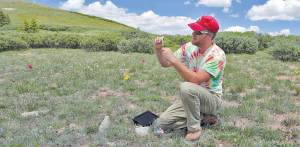By Charles F. Price
One hundred and forty years ago this June, gunfire punctuated the predawn darkness at the base of Land’s Hill on the west side of what is now Hwy. 285 between Salida and Buena Vista. Shot twice from ambush, a homesteader named George Harrington fell dead. His wife, Helen Mary, pulled his body from the flames of a burning outbuilding.
The couple had been trying to extinguish a fire kindled by arsonists to lure them from their nearby dwelling house on Gas Creek, exposing them as targets against the glare of the flames. This murder in the early morning of June 17, 1874, witnessed by the couple’s infant daughter and Harrington’s visiting young sister, ignited the worst calamity in the history of Central Colorado, an event now known as the Lake County War. (The area of the conflict was then in Lake County but became a part of Chaffee County upon its creation in 1879.)
At least ten and perhaps as many as a hundred individuals – no one is sure of the number – died during this struggle between 1874 and 1881, some lynched, others shot, and some as a result of the shock and grief resulting from the violence. Among the dead was a probate judge, son of the respected Methodist circuit-riding minister Rev. John L. Dyer, gunned down in his own courtroom. Other victims were tortured by repeated non-lethal hanging. Many were driven from the valley by death threats. Law and order broke down almost completely although, as one historian has noted, “there was no shortage of constables or other appointed officials within the county.” Indeed, the trouble was that in some instances, those charged with the duty of keeping the peace instead chose sides and actually participated in the factional violence.
For example, after the widow Harrington sought help from the law in the ambush death of her husband, the Lake County sheriff set out to serve a warrant on the suspected murderer, a Gas Creek neighbor of Harrington’s named Elijah Gibbs. But the lawman came not with a posse of duly sworn deputies, but with a party of ranchers and other “Lake Countians” who were reported to be inebriated. Furthermore, judging from their actions, they were intent not on gaining justice in the courts but on lynching Gibbs, who had already been acquitted of the murder in a Denver court.
The story of the Lake County War has often been told, but never thoroughly. Its various incidents are well-known in the lore of the Upper Arkansas Valley, some of them recounted in this magazine in recent years. Less thoroughly explored are the motives and personalities involved. What exactly were the causes and motivations of the hatreds that flared up among the residents of Lake County? Gibbs was immediately suspected of murdering Harrington because the two had recently quarreled over the rights to an irrigation ditch that separated their properties. That argument reportedly ended in violence, although various accounts disagreed some saying Harrington first attacked Gibbs with a shovel, others arguing Gibbs started the trouble by trying to shoot Harrington.
However that may be, press reports of the incident revealed the clash had occurred against a background of long-simmering animosities among the residents of that section of Lake County. Some residents, evidently the longer-established ranchers and other citizens who often referred to themselves as “the best men in the community,” believed Gibbs and some of his associates were actually members of an organized criminal confederation called “The Regulators,” who engaged in cattle rustling, theft, arson and many other crimes. It was believed by some that The Regulators had organized themselves at a meeting in May 1874 meaning to rob and terrorize the southern section of Lake County, and that a counter-organization was required to combat its depredations. Such a group, called the Committee of Safety, was in fact formed and reportedly consisted of some 180 men. However, a local historian, June Shaputis, in her book Where the Bodies Are in Central Chaffee County, Colorado, writes that if cattle were being lost, straying stock was the chief problem, not rustling. The Lake County Commissioners, Shaputis writes, had begun having a yearly roundup in 1872 “to force the owners to claim their loose cattle or the animals would be sold at public auction.”
Rev. Dyer ascribed the frictions in Lake County not to a league of criminals and rustlers that the better citizens sought to break up, but to the fact that, in his words, “The disposition of the older settlers was to domineer over the newcomers. If they submitted, all right; if not, then there were the means to subdue their haughty spirits.” Gibbs, suspected by some as the murderer of Harrington, was a relative newcomer and had, soon after his arrival, rubbed some of the established ranchers the wrong way by resisting the high-handed way older settlers had used his team for a threshing job without asking his permission.
Over time in the early 1870s, Lake County seems to have become a hotbed of aggravations large and small, real and perhaps imagined. The murder of George Harrington struck fire to that dry tinder. While Gibbs and his hired man, Stewart McClish, were charged with the ambush killing, they were acquitted in a Denver court after a trial. Once free, McClish, no doubt cowed by the anger of so many of the powerful men in the county against his employer, abandoned Lake County. But Gibbs, evidently a plucky individual, returned to his Gas Creek home and seemed intent on resuming life as usual. This did not sit well with the Committee of Safety.
As a result, on the moonlit night of Jan. 22, 1875, the Lake County sheriff and a group of vigilantes descended on Gibbs’ home. They were armed with a warrant for assault because Gibbs could not be tried again for Harrington’s murder. They called for him to come out and be hanged like a man, and when he refused, tried to set fire to his cabin despite the fact Gibbs’ pregnant wife was with him, as were his three small children aged one, two and four, a neighbor lady, Mrs. Perry Hutchinson, and her child.
The vigilantes tried to set fire to the north side of the Gibbs’ cabin but recent wet weather had soaked the logs so they refused to burn. The mob then decided to rush the door. Gibbs fought back by firing his six-shooter through chinks in the walls and doorframe of his cabin and wounded David and Samuel Boon; one of the Boons, when hit, discharged his shotgun as he fell and accidentally struck his own uncle Finley (or Finlay) Kane. All three men died over the next few days. What role, if any, the sheriff played in this tragedy has never been revealed, but it would seem obvious that his presence among the would-be lynchers was unwise.
The chastened mob withdrew. Gibbs went to Browns Creek and turned himself in to a constable, pled self-defense and was released. He then set out for Denver but in South Park was chased by several more of the vigilantes, whom he managed to elude. Eventually he, his in-laws and some friends left Lake County. The sheriff had sought him in vain for the deaths of the Boons and Kane; vigilantes next began a campaign of intimidation and violence against those who were suspected of being Gibbs sympathizers or apologists. Several persons were ordered to leave Lake County on pain of death, and complied. Others resisted and were killed or tortured. A virtual reign of terror gripped the county.
In probably the worst incident of these troubles, Probate Judge Elias Dyer, son of the famed minister, was assassinated by gunfire in the county seat of Granite after issuing a warrant for twenty-eight vigilantes who reportedly had subjected Jesse Marion, suspected of having opposed the Committee of Safety, to repeated semi-hangings.
Conditions in Lake County became so dangerous that the governor of Colorado sent David Cook, a famous detective, into the area to try to sort out the difficulties and calm the passions. But for some reason, Cook reported that the troubles in Lake County had largely subsided, an opinion shared by some Denver news accounts issued by members of the Committee of Safety and their supporters. However, difficulties continued throughout the later 1870s.
What may have been the last murder traced to the war occurred Oct. 3, 1881, when ex-vigilante Charles Nachtrieb was shot dead in his store in Nathrop by a cowboy named Bert Remington, said to have been a nephew of George Harrington. Remington’s motive remained obscure since Harrington’s death had precipitated the formation of the Committee of Safety, but the killing has generally been attributed to strife occasioned by the Lake County War. Remington escaped capture and was never punished for the killing.
In the same year that Nachtrieb was killed, a resident of the county by the name of E.R. Emerson contributed an article to a book being compiled about the history of the Upper Arkansas Valley. He referred to the Lake County War as “the foulest blot upon the early history of the county.” In 1974, local historian Ruby G. Williamson wrote a pamphlet about the conflict in which she characterized it by saying, “The whole valley … was crimson with blood.”
This traumatic period in the history of the Upper Arkansas Valley has been the subject of a number of articles in regional magazines and historical journals and has been briefly mentioned in books of regional history. But it has yet to receive a comprehensive book-length treatment. In an effort to remedy this deficiency, Dr. Wendell F. Hutchinson, 90, retired Chaffee County veterinarian and a descendant of pioneer rancher Joseph Sykes Hutchinson, made diligent efforts over the years to interest researchers in undertaking a serious study of the Lake County War. He did engage at least two such researchers, each of whom collected a store of source materials, but each passed away before completing the narrative.
Dr. Hutchinson then looked elsewhere and settled on myself, an author living in Burnsville, North Carolina, who, in 2013, published a book of Colorado history entitled Season of Terror: The Espinosas in Central Colorado, March-October 1863. I have also written a number of historical novels. My wife is the former Ruth Ellen Perschbacher, daughter of Mr. and Mrs. Ray Perschbacher of Salida.
When I agreed to take up work on the proposed book, Dr. Hutchinson arranged to send me the research materials gathered by the previous collaborators. While much work had already been done, even more of the complex story of the Lake County troubles remained to be researched, analyzed and reduced to writing, and I set to work. Assisting me was accomplished Colorado historian and writer Christie Wright, president of the Park County Local History Archives Board and author of South Park Perils: Short Ropes and True Tales of Historic South Park, Colorado.
Wright and I soon learned, as we pored over the records of the time, that while the incidents of the war were well delineated in the records, it was far more difficult to determine the motives and emotions of the individuals concerned – what I call the “sociology” of the prolonged and remorseless siege of violence between former neighbors.
The authors are asking residents whose ancestors were living in Lake/Chaffee County in the early 1870s to contact us with any family stories, diary or journal entries, old newspaper clippings or letters or photographs relating to the conflict, which might give insight into events, personalities and motives. Persons having such information should contact Christie Wright by email at southparkperils@gmail.com or by telephone at 303-346-8542.


